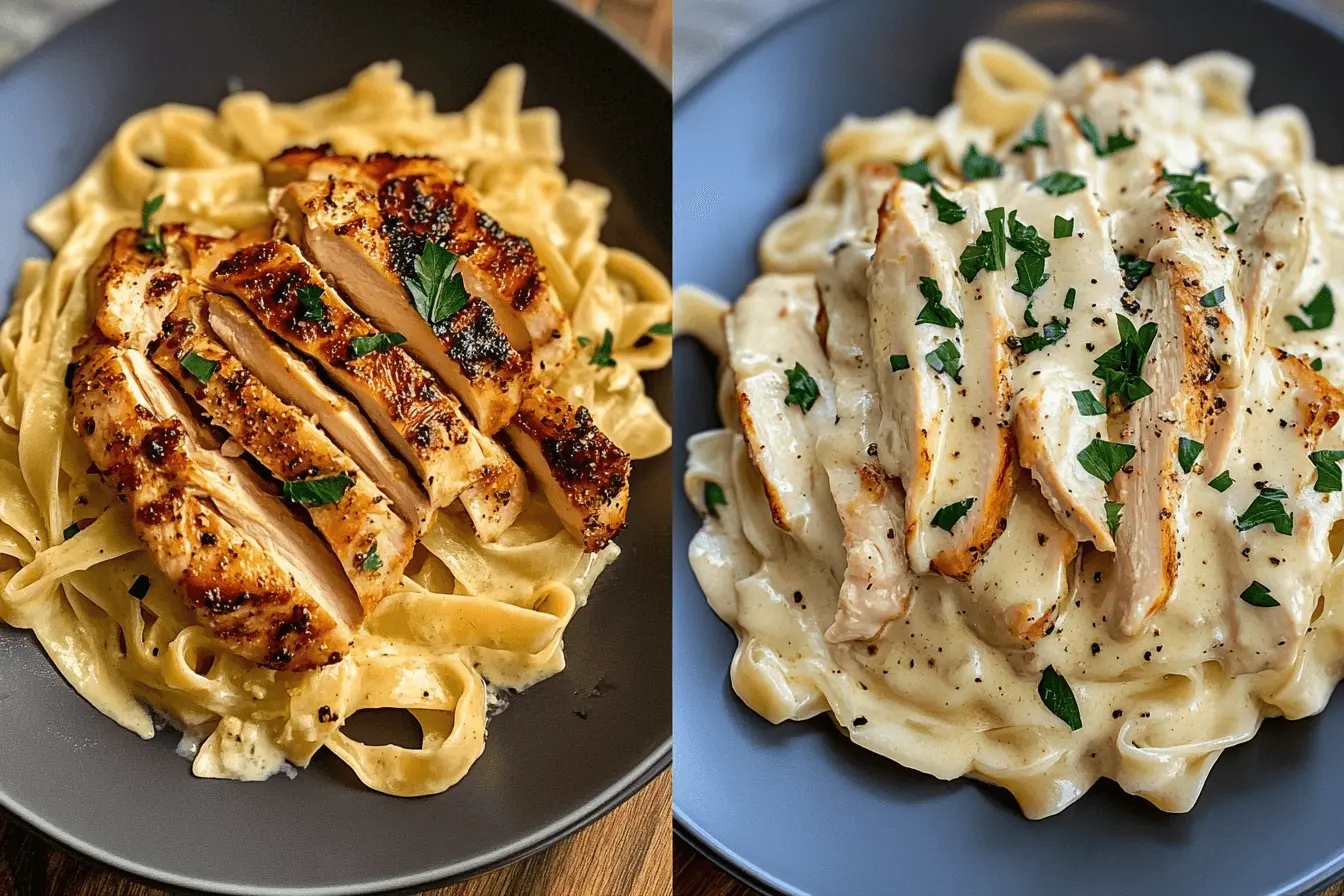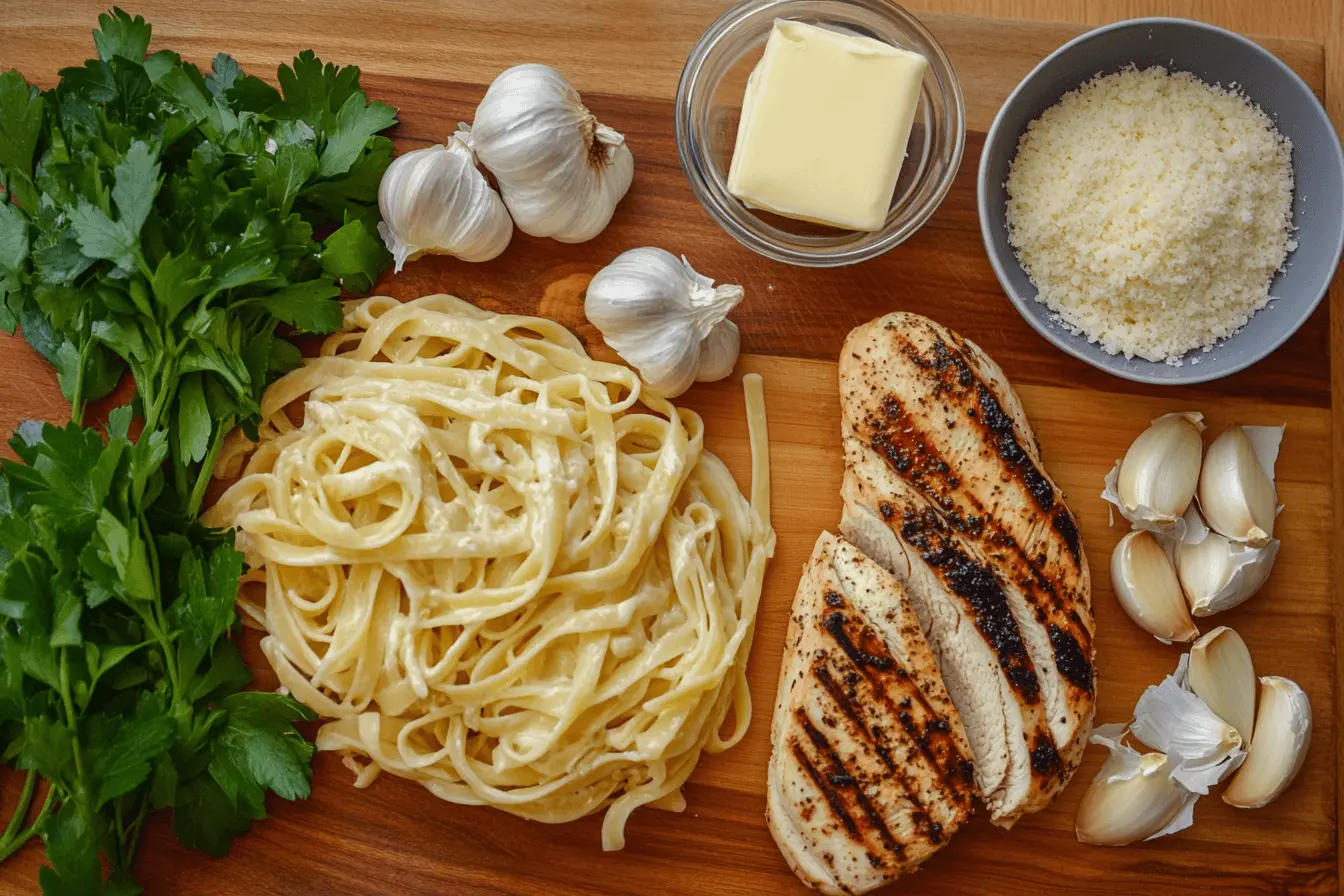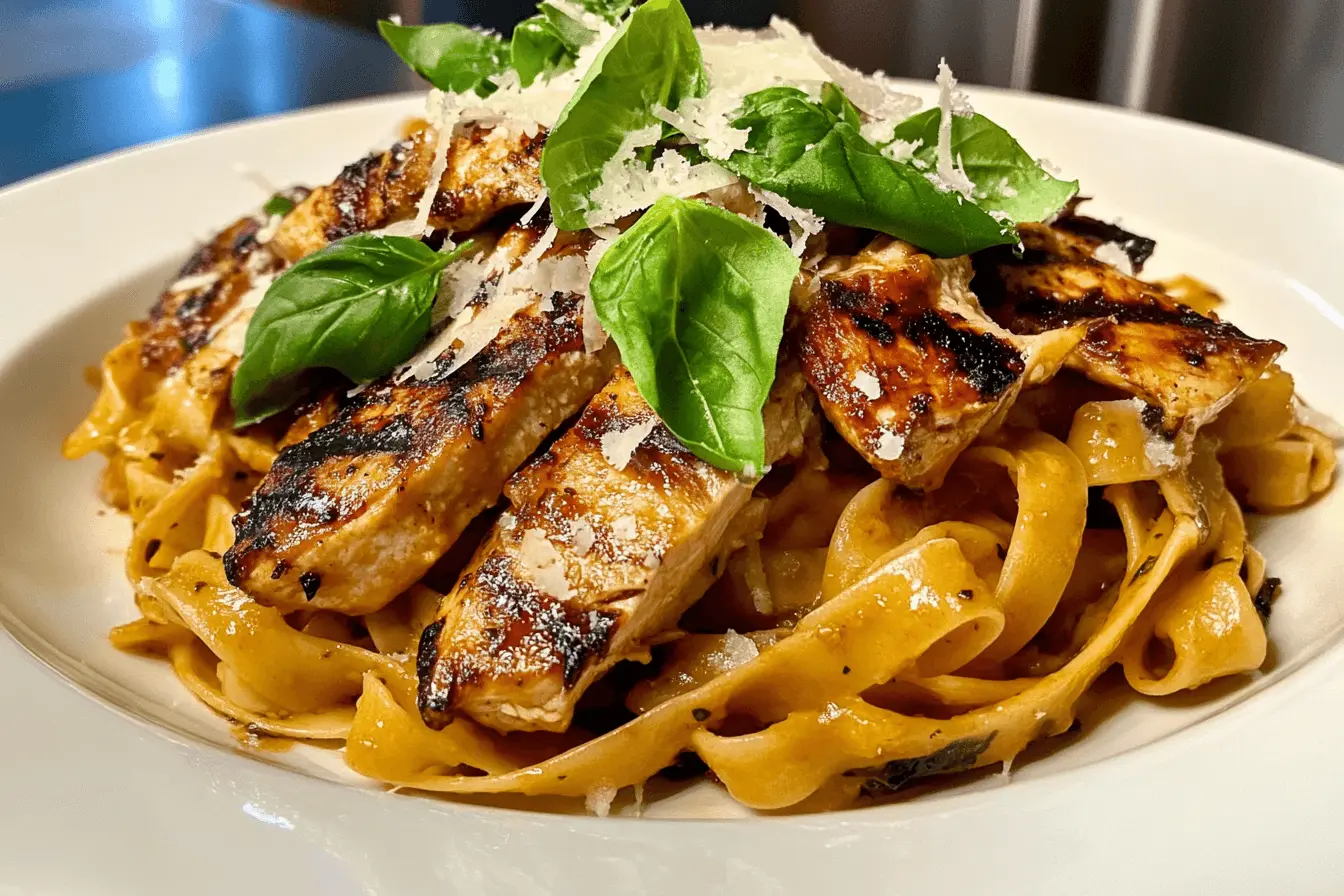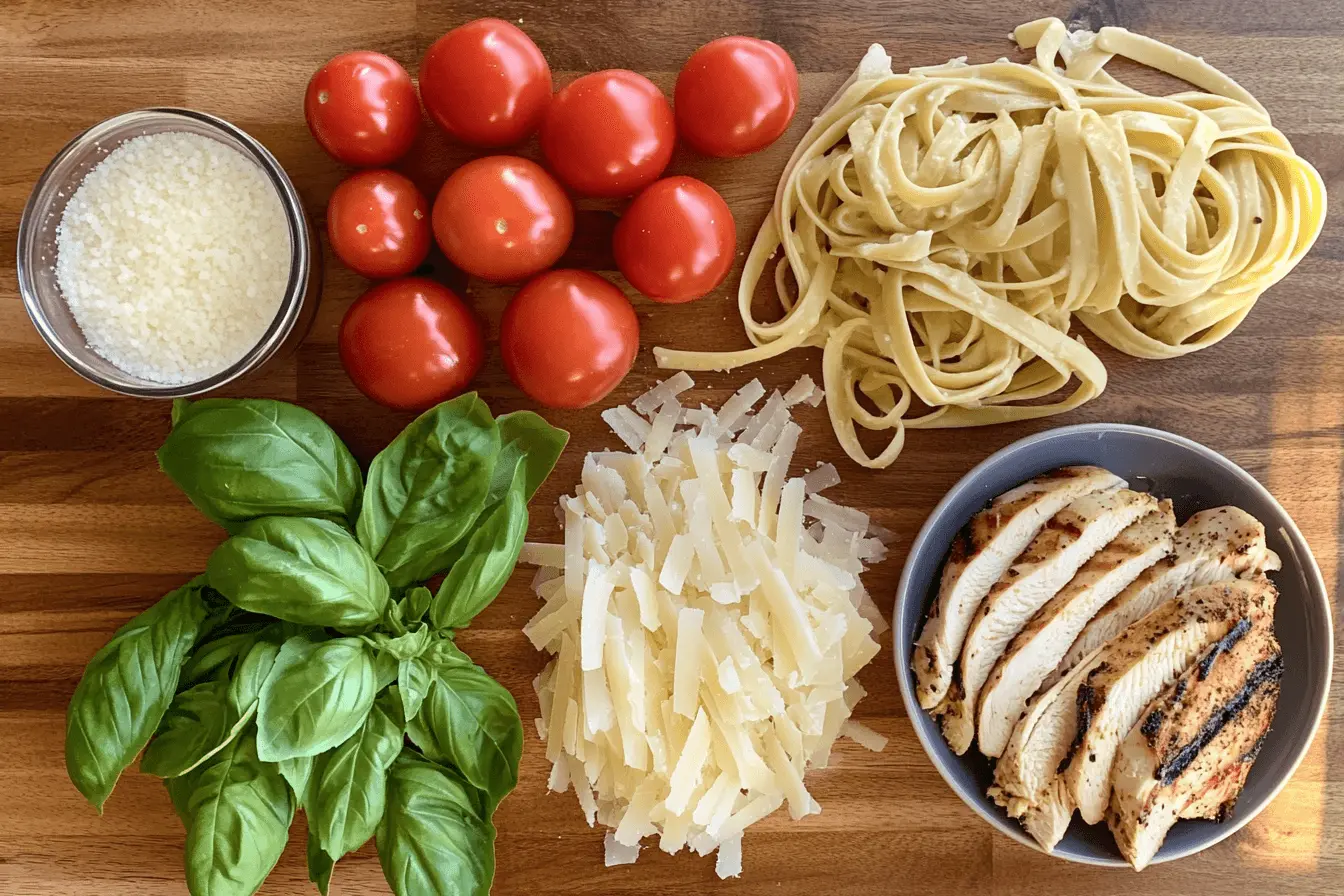Introduction
When it comes to Italian-American cuisine, Chicken Alfredo and Chicken Fettuccine are two beloved dishes that often get confused. Both feature pasta and chicken, but their preparation, flavors, and overall appeal are distinctly different. So, if you’re a foodie or simply trying to decide which dish to enjoy for dinner, you’re probably wondering what sets these two dishes apart.
In this article, we’ll dive deep into the key differences in flavor, ingredients, and preparation in Chicken Alfredo vs Chicken Fettuccine. Find out which dish suits your taste!, exploring their key ingredients, cooking methods, and unique characteristics. By the end of this read, you’ll have a clear understanding of what makes each dish special and how to choose the perfect one for any occasion.
What is Chicken Alfredo?
Chicken Alfredo, often considered an indulgent, creamy delight, is one of the most popular pasta dishes in the United States. It typically consists of fettuccine pasta, grilled or sautéed chicken, and a rich Alfredo sauce. But what makes Chicken Alfredo so appealing is its sauce—silky smooth, velvety, and packed with the deep flavor of butter, cream, and Parmesan cheese.
The Origins of Chicken Alfredo
While the dish is widely associated with Italian cuisine, its origins are more Italian-American than traditional Italian. In fact, the Alfredo sauce was first popularized in Rome by Alfredo di Lelio in the early 1900s. However, in its original form, the dish was a simple combination of butter and cheese, not the heavy cream-based sauce many know today. When it crossed over to America, the sauce evolved to incorporate cream, creating the rich, creamy texture we love.
Key Ingredients in Chicken Alfredo
At the heart of Chicken Alfredo lies its Alfredo sauce, made primarily from cream, butter, and Parmesan cheese. The sauce’s richness is what gives this dish its distinctive flavor profile. Add grilled or sautéed chicken, and you’ve got a dish that’s both satisfying and decadent. Some variations might introduce garlic, parsley, or even extra cheese for that added richness.
Overview of Chicken Fettuccine
While Chicken Alfredo is beloved for its creamy, comforting texture, Chicken Fettuccine offers a different, often lighter experience. The primary difference lies in the sauce, the preparation, and the overall flavor. So, let’s take a closer look at this classic dish and what makes it unique.
What is Chicken Fettuccine?
Chicken Fettuccine is a dish that revolves around its main pasta, fettuccine, which is a broad, flat noodle, and its use of chicken. But unlike Chicken Alfredo, the focus of Chicken Fettuccine is often on the type of sauce or preparation method used, rather than the creaminess that defines its counterpart.
The Origins of Chicken Fettuccine
Much like Chicken Alfredo, Chicken Fettuccine traces its roots to traditional Italian cuisine. However, while Fettuccine originated in Italy, particularly in Rome, the American version often uses various sauces, including marinara or a light olive oil-based sauce, which makes it less rich than Chicken Alfredo. It is typically more versatile and can be customized with numerous seasonings and flavors.
Key Ingredients in Chicken Fettuccine
Chicken Fettuccine features fettuccine pasta paired with grilled or pan-seared chicken. However, the key difference lies in the sauce. While some versions might opt for a light olive oil-based sauce, others may use a tomato-based marinara sauce. The addition of vegetables like spinach, mushrooms, or roasted tomatoes can also elevate the dish’s flavor, giving it a savory edge without the heaviness of cream. It’s a more flexible and lighter option compared to the dense, creamy Alfredo sauce.
How Chicken Fettuccine is Made
The preparation of Chicken Fettuccine can vary depending on the sauce you choose to pair it with. For a basic version, you start by cooking the fettuccine pasta al dente. Meanwhile, the chicken is often grilled or sautéed to achieve a nice sear and tender texture. The sauce is then prepared—whether it’s a tomato sauce, a simple olive oil, or a garlic sauce. The pasta and chicken are then combined with the sauce, garnished with fresh herbs like basil, and sometimes topped with freshly grated Parmesan.
Key Differences Between Chicken Alfredo and Chicken Fettuccine
At first glance, Chicken Alfredo and Chicken Fettuccine may seem quite similar—both dishes feature fettuccine pasta and chicken as the central ingredients. However, when you dive deeper into their preparation, ingredients, and flavors, you’ll quickly realize there are some key distinctions that set these dishes apart. Let’s break it down.
Key Differences in Ingredients
The most noticeable difference between Chicken Alfredo and Chicken Fettuccine is the sauce.
- Chicken Alfredo: The defining feature of Chicken Alfredo is the Alfredo sauce, a rich, creamy blend of butter, heavy cream, and Parmesan cheese. This sauce is what gives the dish its velvety, indulgent texture. The creaminess of the sauce is the centerpiece of the dish, complementing the grilled chicken and fettuccine pasta.
- Chicken Fettuccine: On the other hand, Chicken Fettuccine focuses on the pasta and the choice of sauce. While it can certainly be paired with a creamy sauce, it’s also commonly served with lighter options, such as marinara sauce, olive oil, or even a pesto sauce. The absence of a rich cream sauce makes Chicken Fettuccine a lighter, often healthier alternative to Chicken Alfredo.
Cooking Techniques and Preparation
The cooking techniques used for both dishes can also differ:
- Chicken Alfredo: In Chicken Alfredo, the Alfredo sauce is prepared by melting butter and cream together, then adding Parmesan cheese to create a rich, smooth sauce. The chicken is either grilled or sautéed and added to the pasta, which is then tossed in the creamy sauce.
- Chicken Fettuccine: For Chicken Fettuccine, the pasta is cooked al dente, and the chicken is typically grilled or pan-seared, which gives it a crispy exterior. The sauce can vary, but many versions opt for a lighter base, such as a tomato sauce or olive oil mixed with garlic. The sauce is typically added in moderation, allowing the flavors of the fettuccine pasta and chicken to shine.
Flavor Profile Comparison
- Chicken Alfredo: The Alfredo sauce in Chicken Alfredo is creamy, rich, and cheesy. It’s a dish that is bold, indulgent, and very satisfying. The chicken, while delicious, takes a bit of a backseat to the richness of the sauce.
- Chicken Fettuccine: Chicken Fettuccine, on the other hand, is often lighter in flavor, depending on the sauce used. The marinara or olive oil-based sauce brings a savory, slightly tangy taste that contrasts with the grilled chicken and fettuccine pasta. It’s typically less rich but still full of flavor, offering a refreshing alternative to the creamy indulgence of Chicken Alfredo.
Nutritional Comparison of Chicken Alfredo and Chicken Fettuccine
When it comes to deciding between Chicken Alfredo and Chicken Fettuccine, nutrition is an important factor to consider. While both dishes are hearty and delicious, their calorie counts, fat content, and overall nutritional profiles can differ significantly. Let’s dive into the nutritional breakdown of each dish and see how they compare.
Nutritional Breakdown of Chicken Alfredo
Chicken Alfredo is often considered a comfort food, and it earns this reputation due to its rich, creamy sauce. However, this indulgence comes at a nutritional cost.
- Calories: One of the main considerations when eating Chicken Alfredo is its calorie count. A typical serving of Chicken Alfredo with fettuccine pasta and Alfredo sauce can range from 700 to 1,000 calories, depending on the portion size and specific ingredients used.
- Fat: The creamy Alfredo sauce is made from butter and heavy cream, so it’s quite high in fat—particularly saturated fats. A standard serving can contain 30-40 grams of fat, with a substantial portion being saturated fat.
- Carbohydrates: The fettuccine pasta in Chicken Alfredo is also rich in carbohydrates, contributing roughly 60-70 grams of carbs per serving.
- Protein: On the positive side, Chicken Alfredo provides a good amount of protein, especially if a healthy portion of grilled chicken is added. You can expect around 35-45 grams of protein per serving.
- Other Nutrients: The dish provides essential nutrients, including calcium and iron from the cheese and chicken, though the high fat and calorie count can make it less ideal for those watching their caloric intake or following a low-fat diet.
For those looking to make a healthier version of Chicken Alfredo, there are several modifications you can make. Opting for lighter cream or using alternatives like almond milk can reduce the calorie and fat content, while whole wheat pasta can boost fiber.
Nutritional Breakdown of Chicken Fettuccine
In comparison, Chicken Fettuccine offers a lighter alternative, especially when paired with a non-creamy sauce.
| Nutrition | Chicken Alfredo | Chicken Fettuccine |
|---|---|---|
| Calories | 700–1,000 kcal | 500–700 kcal |
| Fat | 30–40 g (saturated fat) | 10–15 g (unsaturated fat) |
| Carbohydrates | 60–70 g | 60–70 g |
| Protein | 35–45 g | 30–40 g |
| Other Nutrients | Calcium, Iron (from cheese and chicken) | Fiber, Vitamins (especially if vegetables are added) |
When looking for a healthier option, Chicken Fettuccine is a great choice, particularly when it’s paired with lighter sauces. Opting for grilled chicken and adding in vegetables can increase the dish’s nutritional value, making it an excellent option for those looking for a balanced, less calorie-dense meal.
Flavor Profile Comparison
While both Chicken Alfredo and Chicken Fettuccine share a key ingredient in the form of fettuccine pasta and chicken, their overall flavor profiles are quite different. These differences lie in the sauce, seasoning, and preparation methods, giving each dish its own unique taste experience. Let’s explore how the flavors compare between these two dishes.
The Richness of Chicken Alfredo
When you think of Chicken Alfredo, the first thing that likely comes to mind is the rich and creamy sauce that envelops the pasta. The Alfredo sauce—a combination of butter, cream, and Parmesan cheese—provides a luxurious, velvety texture that is both indulgent and satisfying. The flavor is rich, slightly nutty from the Parmesan, and has a subtle buttery taste that melts beautifully on the palate.
- Texture: The creaminess of the sauce coats the pasta and chicken, providing a rich, smooth mouthfeel. This makes Chicken Alfredo a comforting, decadent dish perfect for those who love creamy, cheesy flavors.
- Taste: The flavor of Chicken Alfredo is buttery, cheesy, and savory with just a hint of sweetness from the cream. It’s a well-balanced richness that is perfect for those craving something indulgent. The chicken, while still flavorful, takes a bit of a backseat to the creamy sauce, offering a subtle contrast to the richness of the sauce.
The Lighter Flavor of Chicken Fettuccine
In contrast, Chicken Fettuccine tends to offer a lighter, more savory flavor. While it still features the same fettuccine pasta and chicken, the dish’s sauce plays a significant role in shaping its flavor profile. Often paired with a tomato-based marinara sauce or a light olive oil sauce, Chicken Fettuccine leans towards a fresher, more vibrant taste compared to the richness of Chicken Alfredo.
- Texture: Unlike the creamy texture of Chicken Alfredo, the sauce in Chicken Fettuccine is often thinner and lighter, allowing the flavors of the grilled chicken and fettuccine to come through more clearly.
- Taste: The flavor is fresh and savory, with tangy notes from the tomato sauce or subtle herbs from the olive oil. The chicken retains its crispy exterior from being grilled or pan-seared, offering a satisfying contrast to the softer pasta. This dish has a more balanced, savory taste without the overwhelming richness of a cream-based sauce.
Choosing Between the Two Based on Flavor
Ultimately, the choice between Chicken Alfredo and Chicken Fettuccine comes down to personal preference:
- If you prefer a rich, indulgent, and creamy dish, Chicken Alfredo is your go-to option.
- If you’re looking for something lighter, fresher, and more savory, Chicken Fettuccine is a fantastic choice.
Both dishes offer their own delicious appeal, but their flavor profiles cater to different tastes and dining experiences.
Popular Variations of Each Dish
Both Chicken Alfredo and Chicken Fettuccine have earned their place as classic favorites in Italian-American cuisine. However, these dishes are versatile and can be customized to suit various tastes, dietary preferences, and even health goals. In this section, we’ll explore some popular variations of each dish that allow for creativity in the kitchen.
Variations of Chicken Alfredo
While the classic Chicken Alfredo recipe is well-loved for its creamy, cheesy sauce, many variations can give this dish a fresh twist or cater to dietary needs.
Adding Vegetables
To introduce more flavor and nutritional benefits, many people add vegetables like broccoli, spinach, or mushrooms to Chicken Alfredo. The earthiness of the mushrooms or the slight bitterness of the spinach complements the rich sauce, balancing out the heaviness of the cream.
- Broccoli Alfredo: One popular variation is to add broccoli florets to the dish. The vegetable’s crunchiness adds texture and freshness to the creamy sauce, making it a beloved version for those seeking more greens on their plate.
Protein Alternatives
While grilled chicken is the traditional protein in Chicken Alfredo, you can switch things up by using other meats or even seafood.
- Shrimp Alfredo: This version swaps out chicken for shrimp, offering a lighter, seafood option with the same creamy sauce.
- Turkey or Pork: For those who don’t enjoy chicken, Turkey Alfredo or even a lean Pork Alfredo can offer a different protein source without compromising the creamy texture of the sauce.
Healthier Variations
For those watching their calorie or fat intake, there are ways to make Chicken Alfredo healthier without losing too much of its indulgent flavor.
- Low-Fat Alfredo Sauce: You can use low-fat cream, or even alternatives like almond milk, to make a lighter version of the sauce. Alternatively, you could substitute the butter with olive oil for a healthier fat option.
- Whole Wheat Pasta: Swapping regular pasta for whole wheat pasta increases the fiber content of the dish, making it a more nutritious option.
Variations of Chicken Fettuccine
On the other hand, Chicken Fettuccine is just as versatile and can be modified to suit a wide range of dietary needs and flavor preferences.
Different Sauces
While Chicken Fettuccine is typically served with a tomato or olive oil-based sauce, you can get creative with the type of sauce you use. Here are a few variations:
- Pesto Chicken Fettuccine: Swap out the marinara sauce for pesto sauce, which is made from basil, garlic, Parmesan, and olive oil. The result is a fragrant, herbaceous dish with a delightful texture.
- Garlic Butter Chicken Fettuccine: For a richer variation, a garlic butter sauce can replace the olive oil or tomato sauce, giving the dish a luxurious, savory flavor.
Adding Vegetables
Just like Chicken Alfredo, Chicken Fettuccine can benefit from the addition of vegetables. Some popular options include:
- Grilled Vegetables: Adding grilled vegetables like zucchini, bell peppers, or asparagus can enhance the dish’s flavor and provide more nutrients.
- Spinach and Artichoke: A delicious combination for those who love creamy, cheesy flavors. Spinach and artichoke hearts can be incorporated into the sauce to give the dish a unique texture and flavor profile.
Health-Conscious Modifications
For a lighter or more health-conscious version of Chicken Fettuccine, there are a variety of ways to make the dish a bit healthier.
- Zoodles (Zucchini Noodles): For a gluten-free or lower-carb option, you can substitute regular pasta with zucchini noodles (also known as zoodles). These noodles are light, refreshing, and lower in calories.
- Lean Proteins: While chicken is the traditional protein, grilled shrimp or tofu can be used for a lighter, pescatarian, or vegetarian variation of the dish.
Serving Suggestions for Chicken Alfredo and Chicken Fettuccine
Both Chicken Alfredo and Chicken Fettuccine are hearty dishes that benefit from thoughtful side dishes and pairings to round out the meal.
Ideal Pairings for Chicken Alfredo
- Sides: Garlic bread, Caesar salad, or roasted vegetables are excellent accompaniments to Chicken Alfredo. The richness of the sauce pairs wonderfully with a light, crisp salad or the satisfying crunch of garlic bread.
Best Pairings for Chicken Fettuccine
- Sides: For Chicken Fettuccine, try pairing it with roasted vegetables, grilled asparagus, or a light green salad. The lighter sauce allows these sides to shine without overpowering the meal.
Both dishes are versatile and can be adjusted based on personal preferences and dietary goals, making them perfect for any occasion.
FAQs About Chicken Alfredo vs Chicken Fettuccine
Is Chicken Alfredo the same as Fettuccine Alfredo?
No, Chicken Alfredo and Fettuccine Alfredo are not the same, though they share a similar base. Fettuccine Alfredo refers to the pasta (fettuccine) served with a rich, creamy Alfredo sauce. Chicken Alfredo is simply Fettuccine Alfredo with the addition of chicken. So, while both dishes feature the same pasta and sauce, Chicken Alfredo adds a protein element.
Can I make Chicken Fettuccine with Alfredo sauce?
Yes, you can. In fact, Chicken Fettuccine Alfredo is a popular variation of Chicken Fettuccine, where the pasta and chicken are served with a rich Alfredo sauce. This brings the creamy texture of Alfredo sauce into the lighter dish of Chicken Fettuccine, creating a fusion of both flavors. You can find a recipe for this variation here.
Which dish is healthier, Chicken Alfredo or Chicken Fettuccine?
Generally, Chicken Fettuccine is considered a lighter option, especially when served with a non-creamy sauce like marinara or olive oil-based sauce. On the other hand, Chicken Alfredo is heavier, primarily due to the cream-based Alfredo sauce, which is rich in fat and calories. If you’re looking to reduce calories or fat, you might opt for Chicken Fettuccine with a lighter sauce. For healthier alternatives, consider using chickpea pasta, which is better for your health. Learn more about chickpea pasta here.
Is Chicken Fettuccine a traditional Italian dish?
While fettuccine is a traditional Italian pasta, Chicken Fettuccine is more of an Italian-American creation. In traditional Italian cuisine, fettuccine is often paired with lighter sauces, such as marinara, or served with various meats or seafood. The Chicken Fettuccine we know today is more common in American restaurants and is often served with creamy sauces like Alfredo.
Can I use different types of pasta for Chicken Alfredo?
Absolutely! While fettuccine is the most traditional pasta used for Chicken Alfredo, you can swap it out for other types of pasta such as penne, rigatoni, or spaghetti. The creamy Alfredo sauce will pair well with any pasta shape, but the fettuccine offers a classic touch due to its wide, flat shape, which allows for more sauce to cling to it.
What’s the best way to reheat leftover Chicken Alfredo or Chicken Fettuccine?
To reheat Chicken Alfredo or Chicken Fettuccine, it’s best to use low heat on the stove to prevent the sauce from separating. Add a splash of milk or cream to help bring back the creamy texture. Stir constantly to ensure it heats evenly. Avoid reheating in the microwave unless necessary, as it can cause the sauce to lose its creamy consistency.





